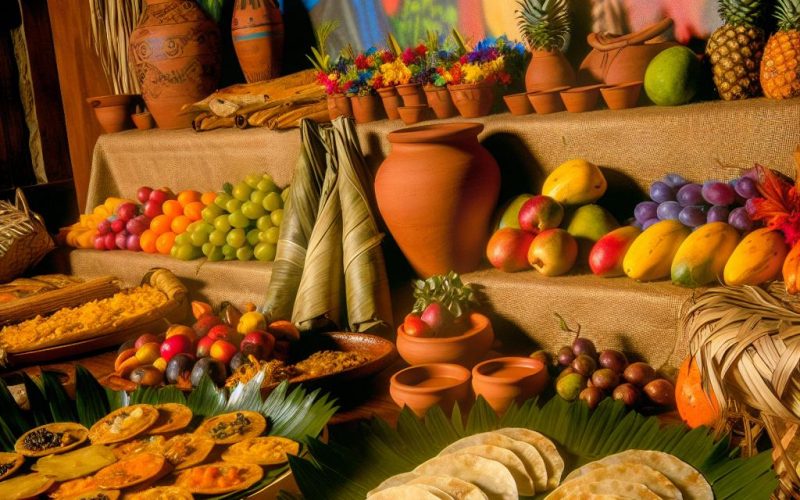Central American Cuisine: Flavors and Traditions
Central American cuisine presents a vivid tapestry of flavors and enduring traditions, shaped by a distinctive blend of influences from indigenous peoples, African heritage, and Spanish colonialism. This culinary tradition showcases a plethora of dishes that not only reflect the region’s rich history but also its varied geography.
Staple Ingredients
A defining feature of Central American cuisine is its dependence on staple ingredients such as corn, beans, and rice. Historically, corn has been a fundamental element since pre-Columbian times, often crafted into tortillas or woven into delicious tamales. Beans, with a preference for black and red varieties, are a ubiquitous presence across meals, served either as a hearty side dish or as a key component in the central dish. Rice also occupies a pivotal role, frequently found accompanying meals or partnered with beans to create the beloved traditional dish known as gallo pinto.
Central America stands as a region where these staples are celebrated daily, transforming ordinary ingredients into outstanding culinary statements. Corn, affectionately termed the kernel of the Americas, forms the backbone of Central American diets. Ground into masa, a dough used for tortillas and tamales, it becomes the vessel carrying flavors across tables. Beans contribute protein and texture to meals, symbolizing frugality merged with taste. The presence of rice ties these components together, creating a uniquely Central American palate that is both staple-driven and taste-enriched.
Influential Flavors
The cuisine is further distinguished by its array of flavors, wherein a medley of herbs and spices is utilized to elevate the culinary experience. Key seasonings include cilantro, oregano, and achiote—a spice prized not only for its vibrant hue but also its distinctive flavor. The employment of chilies stands as another significant element contributing to the depth and, in some instances, the fiery heat of countless dishes. Nonetheless, the degree to which chilies are used varies significantly across the region.
Central American nations exhibit a deftness in balancing flavors, where herbs infuse light freshness while spices add depth. Such is the role of cilantro, its fresh, citrusy notes enhancing salsas and salads alike. Oregano introduces earthy undertones, unfurling its character across grilled meats and roasted vegetables. Achiote, typically shared as a paste or powder, imparts earthy, peppery flavors coupled with a brilliant red-orange color, often a hallmark of specific traditional dishes. It is this symphony of influences and seasonings that imbues Central American cuisine with its unique identity.
Regional Variations
The rich culinary landscape of Central America is further enriched by the regional idiosyncrasies that each country contributes to the traditional dishes. Belizean cuisine, for instance, proudly carries Caribbean influences, exemplified in dishes such as rice and beans cooked with creamy coconut milk, infusing the meal with both tropical flavor and fragrance. In Honduras, one encounters the culinary impact of the Garifuna people through dishes such as machuca, a comforting soup skillfully prepared with coconut milk, fish, and mashed green plantains.
Other regions maintain their own unique culinary identities. Nicaragua’s offerings may introduce vigaron, a street food dish combining boiled yucca and pork served over vinegary cabbage slaw. Meanwhile, Panama serves up sancocho, a traditional chicken soup seasoned with cilantro that is heartwarming and nourishing. As such, each country’s unique take on cuisine showcases a fascinating medley of culinary heritage and innovation.
Traditional Dishes
The menu of traditional Central American dishes glistens with diversity and depth, with many signature items becoming cultural icons in their own right. Take El Salvador’s beloved pupusas, for example. A thick corn tortilla filled generously with cheese, beans, or meat, it is humble yet satisfying, making it a staple of both domestic meals and street food vendors. In Guatemala, the savory stew known as pepian features a delectable amalgamation of meats, vegetables, and lavish spices, all coalescing into a dish that demands appreciation and savoring.
Costa Rica’s casado is a menu staple renowned for its comprehensive composition, combining proteins such as fish or meat with essentials like rice, beans, and plantains. It is these dishes, forged and refined across generations, that tell the deeper story of Central American culinary tradition—a story of locality, resourcefulness, and communal identity.
Culinary Traditions and Celebrations
Meals in Central America are imbued with cultural significance, closely intertwined with celebrations and traditions. The preparation of certain dishes often coincides with special occasions or festivals, underscoring the pivotal role food plays in cultural and familial gatherings. A lauded example is the {tamale}, a dish frequently prepared during holidays, shaped by a deliberate melding of spices and regional ingredients to captivate and celebrate togetherness.
Culinary traditions often dictate that communal activities accompany food preparation, and thus these events become vessels for transmitting heritage and customs across generations. Celebrations such as Day of the Dead or Semana Santa encourage families to preserve these culinary customs, ensuring that traditional recipes do not fall out of favor despite the passage of time.
Preservation of Culinary Heritage
Efforts dedicated to preserving and promoting Central American culinary heritage have found buoyancy among chefs, food historians, and home cooks eager to maintain the authenticity of traditional recipes while simultaneously adapting to contemporary tastes. By prioritizing the use of local ingredients and upholding time-honored cooking methods, these efforts aim to keep the rich food legacies of this region vibrant and ever-evolving.
As much as these preservation efforts underscore an eagerness to retain the regional culinary soul, they also foster innovation and reinterpretation. By carefully blending tradition with modernity, Central American cuisine can continuously intrigue and satisfy the palates of food enthusiasts worldwide. For those desiring to delve deeper into Central American culinary practices, exploring reputable resources online is recommended. Moreover, supporting local guides who offer cooking classes and culinary tours can provide intimate, one-of-a-kind insights into the region’s gastronomic treasures.
